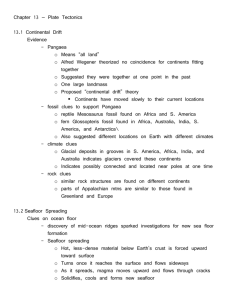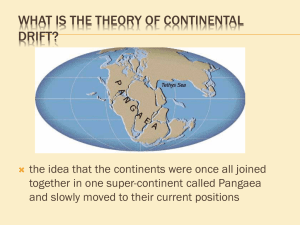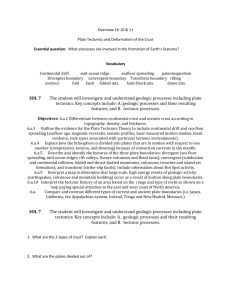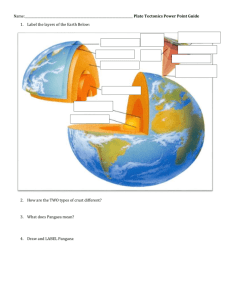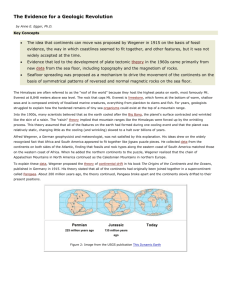evidence- plate tectonic
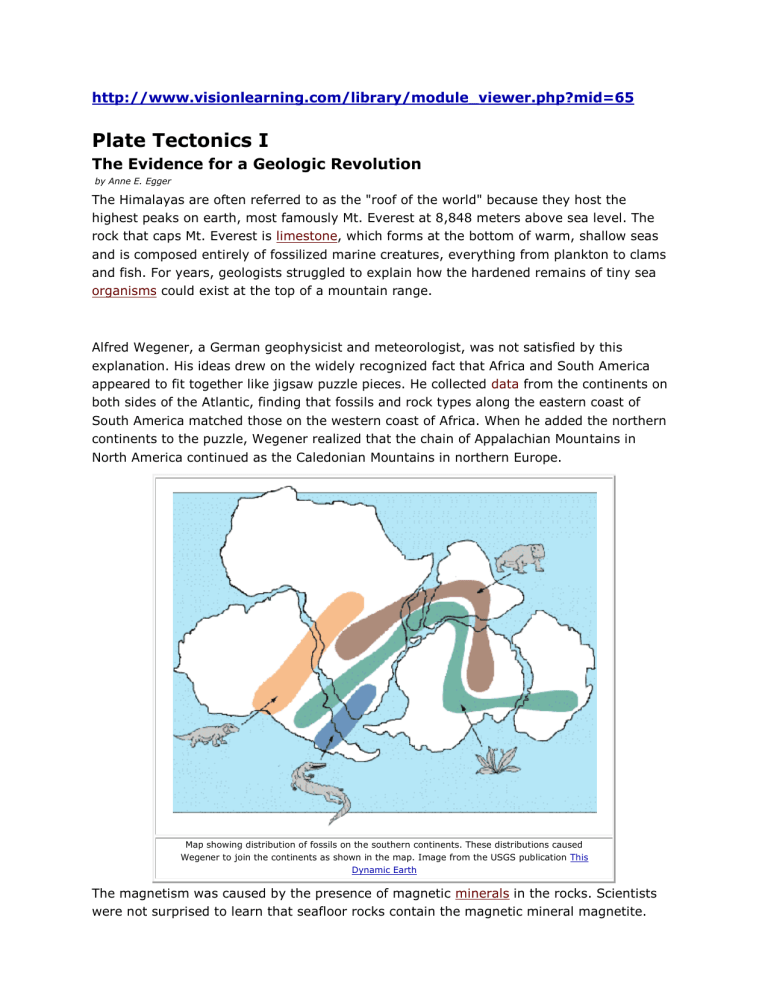
http://www.visionlearning.com/library/module_viewer.php?mid=65
Plate Tectonics I
The Evidence for a Geologic Revolution
by Anne E. Egger
The Himalayas are often referred to as the "roof of the world" because they host the highest peaks on earth, most famously Mt. Everest at 8,848 meters above sea level. The rock that caps Mt. Everest is limestone , which forms at the bottom of warm, shallow seas and is composed entirely of fossilized marine creatures, everything from plankton to clams and fish. For years, geologists struggled to explain how the hardened remains of tiny sea organisms could exist at the top of a mountain range.
Alfred Wegener, a German geophysicist and meteorologist, was not satisfied by this explanation. His ideas drew on the widely recognized fact that Africa and South America appeared to fit together like jigsaw puzzle pieces. He collected data from the continents on both sides of the Atlantic, finding that fossils and rock types along the eastern coast of
South America matched those on the western coast of Africa. When he added the northern continents to the puzzle, Wegener realized that the chain of Appalachian Mountains in
North America continued as the Caledonian Mountains in northern Europe.
Map showing distribution of fossils on the southern continents. These distributions caused
Wegener to join the continents as shown in the map. Image from the USGS publication This
Dynamic Earth
The magnetism was caused by the presence of magnetic minerals in the rocks. Scientists were not surprised to learn that seafloor rocks contain the magnetic mineral magnetite.
When magma from the ridges rises and cools, it crystallizes, locking the magnetite crystals into alignment with the earth's magnetic field like the needle of a compass (see our Earth
Structure module). The existence of the earth's magnetic field had been known since ancient times, but only after World War II did scientists realize that the magnetic field is not constant - it fluctuates in intensity and occasionally even reverses itself. Today we consider the field to have "normal" polarity , and our compass needles point to the north.
But at various times in the past, the polarity has been reversed - any compass needles would have instead pointed to the South Pole. This phenomenon of magnetic reversals had previously been observed in continental rocks, and was clearly the case for oceanic rocks as well.
In 1963, Fred Vine and Drummond Matthews , two British geologists, joined the map of the
Mid-Atlantic Ridge with the symmetric bands of magnetism on the seafloor. Where the navy ships mapped strong magnetism, rocks showed normal polarity ; where they mapped bands of weak magnetism, the rocks showed reversed polarity. These strongly patterned paleomagnetic reversals recorded on the seafloor provided the necessary proof of Hess's seafloor spreading . Specifically, they proved that new crust was continuously being generated at the mid-ocean ridges, where magma cooled and magnetite crystals "locked in" according to the orientation of the earth's magnetic field at that time. The continents no longer had to "drift" to their present locations-they were driven by the slow and steady magma "conveyor belts" at the mid-ocean ridges .
The Himalayas, as it turns out, started forming about 40 million years ago when the Indian
Plate collided head-on with the Eurasian Plate, shoving and folding rocks that had formed below sea level into lofty peaks. Because the Indian Plate is still moving northward, the
Himalayas are still rising at a rate of about 1 cm per year. We no longer need to invoke a shrinking, wrinkled earth to explain the marine fossils at the top of the world.
The earth is incredibly dynamic - mountain chains build and erode away, volcanoes erupt and go extinct, seas advance and recede - and these changes are all a result of the processes of plate tectonics. Before Wegener, few had conceived of such a world. His continental drift theory was the first step in the development of plate tectonic theory, the foundation upon which modern geology is built.
http://geology.csupomona.edu/drjessey/class/Gsc101/Plate.html
Paleoclimatic Evidence a. Glacial deposits at equator b. Coral reefs in Antarctica
Plate Tectonics
Theory of Plate Tectonics is born. Plate - is a rigid piece of lithosphere floating on a partially plastic substrate (asthenosphere).
Seven Major Plates ( See Figure in your Text )
1. Pacific
2. North American
3. South American
4. African
5. Eurasian
6. Antarctic
7. Indo-Australian
Types of Plate Boundaries (Figure)
A. Divergent ( Figure )- Spreading Center - Constructive Margin. Characterized by ocean ridges and sea floor spreading.
B. Convergent - ( Figure ) Characterized by trenches and island arcs
1. Ocean - Ocean (Japanese Islands)
2. Ocean - Continental (Cascade Mountains)
3. Continent - Continent (Himalayas)
C. Transform - Plates moving past one another along strike- slip faults. ( Figure )
http://www.infoplease.com/ipa/A0001765.html
http://msnucleus.org/membership/html/jh/earth/platetectonics/lesson1/platetec1c.html
PLATE TECTONICS
Lesson 1 - Page 3
Next
Plates can collide to build mountains in different ways. They can create trenches and island arcs when oceanic crust and oceanic crust
"bump" into each other. This creates volcanoes and earthquakes. An example of this type of collision is the
Japanese Islands in the western
Pacific Ocean. You can also have oceanic crust collide with continental crust, like you have along northern
California to Washington coastline.
This creates trenches and volcanic mountains. Earthquakes are common in this type of collision. Continental crust that bumps into another continental crust produces very large mountain ranges, like in the Himalaya
Mountains on the southern Asian continent. This produces earthquakes but no volcanoes.
http://www.sio.ucsd.edu/voyager/earth_puzzle/
I t was known that lands now far apart and with very different climates contained the same kinds of fossil plants and animals. For example, certain dinosaur fossils have been found across central South America and western central Africa, and nowhere else. Identical fossil plants have been found in southern South America, southern Africa, India, Antarctica, and Australia.
Evidence of an ancient glacier that was once one large ice cap can be found in South America,
Africa, India, and Australia. These areas would join if the present continents were moved so that they fitted together into one whole. But no one could explain how or why this movement might happen. http://www.geo.ua.edu/intro03/Plate.html
Evidence for Continental Drift
Fit of Continents - Continental slopes of S. America and Africa at 2,000 meters depth match in shape like pieces of a jigsaw puzzle.
Rock and Structural Similarities - Mountain chains that end abruptly at the edge of a continent can be traced to continue on another continent on the other side of an ocean.
Rock types and ages correlate across continents, as well as faults.
Paleoclimates - Rock deposits restricted to certain climates (glacial till, coal, evaporites) have been found in areas having very
different climates today. Glacial deposits of Paleozoic age covered sections of S.
America, Africa, India, Antarctica, and Australia (Gondwanaland). Other rock deposits
(coal and evaporites) show matches across the Northern Hemisphere continents (Laurasia) and indicate a tropical climate (location near equator).
Fossil Evidence - Most compelling of the older evidence for continental drift. Uniform plant fossils of distinct type (Glossopteris floral) have been found in equivalent-aged rock on the Gondwanaland continents only. Seeds were too large to have been wind-carried across oceans and present-day climates are too varied. Restricted animal fossils:
Mesosaurus (a freshwater reptile) and 2 land-dwelling reptiles, also point to linkages of S.
America, Africa, and Antarctica.

